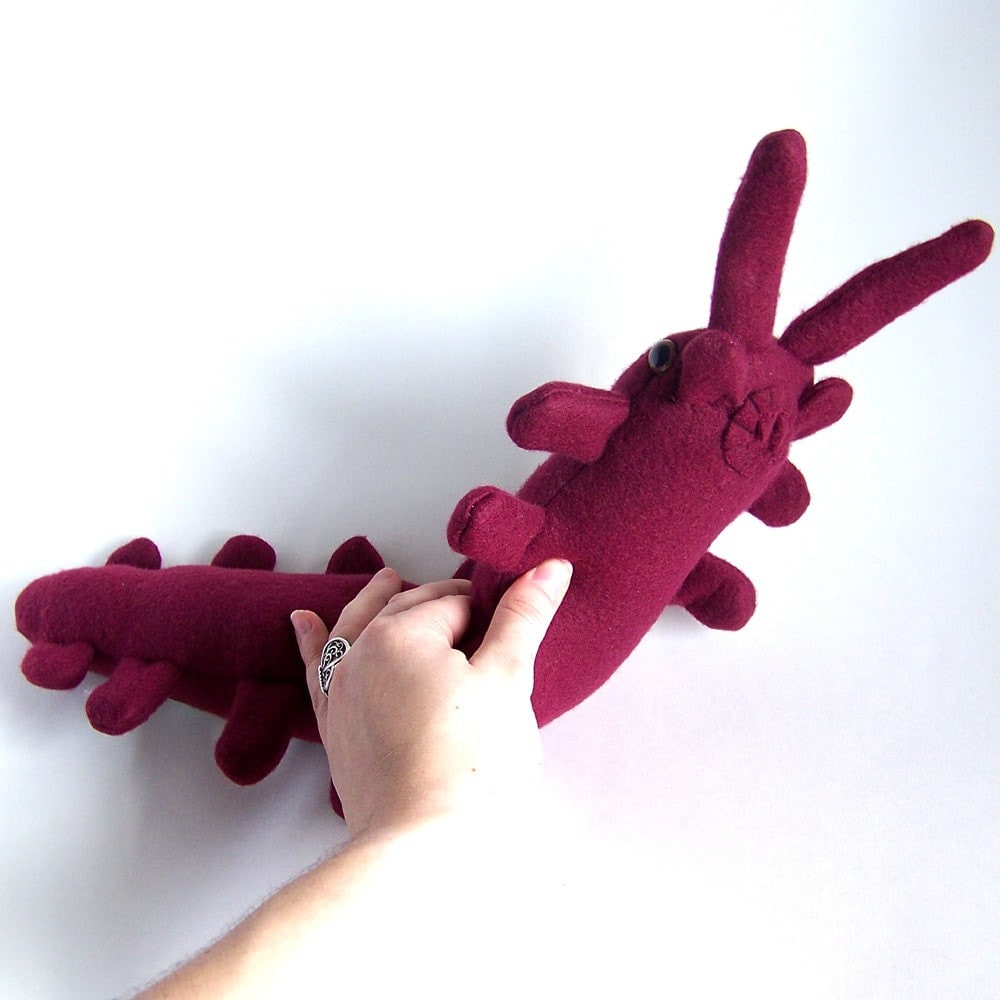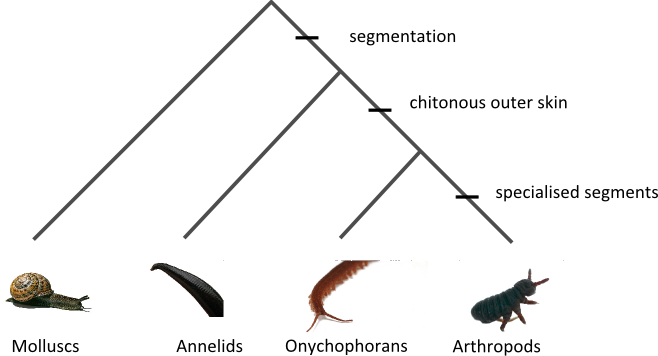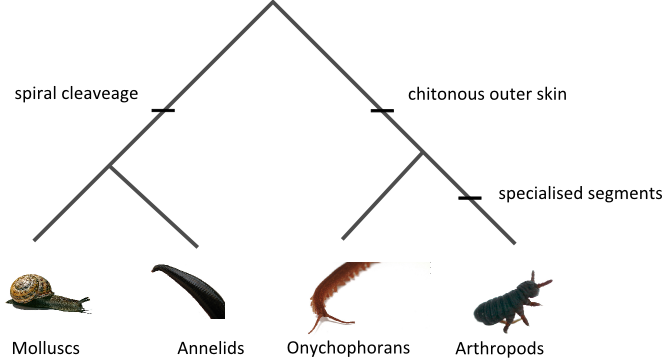Sunday, August 15, 2010
Sunday Spinelessness - Peripatus!!!
I really like Te Ara, the online New Zealand encyclopedia. I can't begin to tell you how many of my posts here have been made better by the information and the illustrations at that website. Two events last week have made me like Te Ara even more. First, it now includes an article written by my Dad; and second the folks behind Te Ara's twitter account replaced their profile picture with a peripatus (Onychophoran). Peripatus might just be the most wonderful animals that there are - nocturnal predators that crawl through leaf litter killing their prey after immobilising them with glue shot from their heads while still managing to look cute. They've also been the subject of some woolly evolutionary thinking, and New Zealand's peripatus are the centre of one of country's most interesting evolutionary debates. So, in honour of Te Ara's fine taste in profile pictures, today's post is all about our peripatus
 Peripatoides sp. image is CC 2.0 from Flickr user Bruno C. Vellutni
Peripatoides sp. image is CC 2.0 from Flickr user Bruno C. Vellutni
I should probably start with the name. So called "walking worms" or "velvet worms" like the Perpatoides above all belong to the phylum Onychophora (the name refers to the claws on the end of each of those legs). In New Zealand we invariably call our species"peripatus" despite the fact that none of them have ever been considered to be part of the tropical genus Peripatus. I can't quite work out how the name peripatus took hold in the public understanding of these creatures, but it hardly matters as long as we all know what we're talking about. In fact, using peripatus as a common name in English makes for a nice congruence, since that name comes from Latin meaning "to walk about" and the Maori name for these creatures, ngaokeoke derives from the verb "to crawl". And it's fun to say (Stephen Jay Gould claimed he'd never written about onychophorans without mentioning how much he liked to hear the word peripatus).
As I mentioned above, peripatus spend their lives in leaf litter and rotting logs. A couple of years ago I spent a fair amount of my summer walking through forests pulling apart rotting logs looking for certain species of springtails. The springtails we were looking for were few and far between, so you did a lot more searching than finding, but looking through rotting logs always throws up interesting creatures. I couldn't count the number of spiders, bizarre harvestmen, smart little native cockroaches, beetles, centipedes, millipedes and snails I found. But I remember each of the three times I encountered a peripatus. There is something very special about running into one of these creatures in their natural habitat, as they crawl away on legs almost identical to the ones that supported their (marine) ancestors 500 million years ago. But peripatus are more than "living fossils" (actually, nothing's a living fossil, every creature on earth has been evolving for 3.8 billion years) almost everything about these animals is amazing.Their fleshy little legs work without a skeleton (inside our out) because their body is inflated with an incompressible liquid that muscles can work against, they shoot glue across (relatively) large distances to immobilse their prey, they have pretty complex brains and (among Australian species at least) complex social behaviours and for all their lack of morphological diversity they have a great variety of reproductive strategies. Most species are ovoviviparous, which means the young develop in eggs which are retained in the female where they hatch a little while before they are born. A few New Zealand an Australian species lay eggs which are supplied with yolk and left alone and others have gone in the other direction and taken eggs out the equation by giving birth to live young nourished by a placenta. All that and they remain, in the words of PsiWavefront "[really quite] adorable"

A plush peripatus from Weird Bug Lady's amazing Etsy shop
Peripatus have also fueled some slightly wonky evolutionary thinking, including perhaps the single stupidest idea to be published in a scientific journal - that insects like butterflies and wasps and beetles which have caterpillar-like larvae are the result of ancient hybridisation between caterpillar-like onychophorans and some flying insect. I don't think that idea is likely to become widespread but it's almost impossible to read about peripatus without coming across the idea that they form a "missing link" between the arthropods (animals with jointed limbs and exoskeletons like spiders, insects and crustaceans) and the annelids (earthworms, leeches and their relatives). There is probably no term that annoys me more than "missing link" - its continued use betrays the way we've failed to include what we know about evolution in the way we think about biology. By now we should know that links belong in chains and species belong in trees. More specifically, the term missing link comes from a theological idea called the Great Chain of Being or Scala Naturae which was meant to relate all of Creation in a giant hierarchy from God, who set it all in place, on down to mud with angels, kings, men, women (occasionally in that order) animals and plants filling the gaps. When natural historians brought up in the age of the Great Chain turned their eyes on the biological world they looked for creatures that could fill up the spaces, smoothly linking the "high" and the "low" animals. In that light you might see the stumpy little legs of onychophorans as filling the space between annelids (with segments but never true legs) and arthropods (with segments and specialised limbs associated with particular segments). Something like this:

But ever since Darwin we've known that animals weren't created to fill a spot in a hierarchy. Rather, they've arisen in a branching pattern, with new lineages forming from the repeated splitting of older ones. Modern species aren't links in an evolutionary chain, they are tips in an evolutionary tree. In this way evolution is actually a process that creates gaps - once a lineage splits each of the daughter lineages are free to evolve away from each. If anything the mixture of "worm-like" and "arthropod-like" character in peripatus might be evidence for shared ancestory between these groups (ie, all these groups descend from a segmented ancestor not shared by the un-segmented animals like molluscs) which would help us to understand the order in which those character evolved:

In the tree above the Onychophorans aren't a link between arthropods and annelids, they are their own group with some degree of shared ancestory with each other group. As it happens, when you look at more characters (especially the nervous system, embryonic development and DNA) the apparent relationship between annelids and peripatus breaks down. The "worm-like" properties of the onychophorans are likely down to each group independently arriving at the same solution to problems arising from life as a tubular invertebrate or the maintenance of traits found in the ancestor of all animals and since modified in most lineages but not these ones. Here's how we'd relate the four groups we've been looking at above given what we know today ("spiral cleavage" is a pattern of embryonic development shared by most lophotrochozoan animals):

On top of being a biological marvels, New Zealand's peripatus might be able to tell us about our county's geology. In fact, our peripatus might just be the only animals keeping New Zealand above water during the Oligicene. New Zealand got its geological start about 85 million years ago when the land that makes up our mini-continent split away from the super-continent Gondwana and for a long time it was considered likely that most of flora and fauna were on board when the split happened. That geological event and it's biological ramifications have become something of a creation myth for New Zealanders, it suits our image as a a rugged and unique country forging its own way through the world. It just happens to be wrong. Or at least, it's become increasingly clear that most of our flora and fauna are relatively recent arrivals (having been blown or rafted to our litltle islands) and some geologists have suggested the whole of New Zealand may have been underwater in the "Oligicence drowning" about 23 million years ago, an event that would have extinguished any Gondwanan refugees. Our peripatus form part of the debate because their relatives are found in Australia, South America and Africa - all formerly part of Gondwana - and as such provide us with the means to test the idea that our peripatus have been in New Zealand since New Zealand existed. Earlier this year Julia Allwood and colleagues presented a molecular clock study focusing on New Zealand and Australian onychophoran species. The molecular clock doesn't tick as smoothly as a wristwatch, so good dating studies like Allwood et al's almost always include large error bars. Nevertheless, they found that the oldest split between Australian and New Zealand genera was between 24.5 and 136.7 million years, with a point estimate just under 80 million years. It's not quite and open and shut case, but it's probably enough to make our peripatus the best candidate for a Gondwanan relict in New Zealand.
The trees and the chain use the following images: Snail from Hadi Fooladi, Leech from PhatController, Onychophoran from Ant Boy and springtail from Cornell Mushroom Blog. All are licensed under Creative Commons 2.0 license (as is everything here that isn't credited to someone else)
Allwood and colleagues' paper is
Allwood, J., Gleeson, D., Mayer, G., Daniels, S., Beggs, J., & Buckley, T. (2010). Support for vicariant origins of the New Zealand Onychophora Journal of Biogeography, 37 (4), 669-681 DOI: 10.1111/j.1365-2699.2009.02233.x
Labels: evolution, onychophoran, perpipatus, sci-blogs, sunday spinelessness
10 Comments:
In fact the NZ ones are less than 10cm long, so you can probably dial down the horror
¡dn ʇı dǝǝʞ ˙pooƃ sʞooן ƃoןq ɹnoʎ
¿noʎ ǝɹɐ ʍoɥ ¡oןןǝɥ
I tend to agree actually, the infauna and freshwater inverts are probably the best argument for gondwanic elements in NZ. I guess I chose the peripatus example because it's one that's gone the next step and been tested.
I hope to write a full length post on the controversry, because it really is interesting!
Thanks for the info - I had no idea that there were so many in NZ - I've never found them here - need to go hunting I think.
Cheers,
DrYak
There are definitely peripatus out there in New Zealand. Being predators they tend to have very patchy ditsrbutions - you can turn over a lot of logs and leaf litter before you find one.
Of course, you always finding something interesting when you start doing that
ugg ショートブーツ
[url=http://www.jyoseiboots.com/]UGGムートンブーツ[/url]
http://www.jyoseiboots.com/ アグ ブーツ




